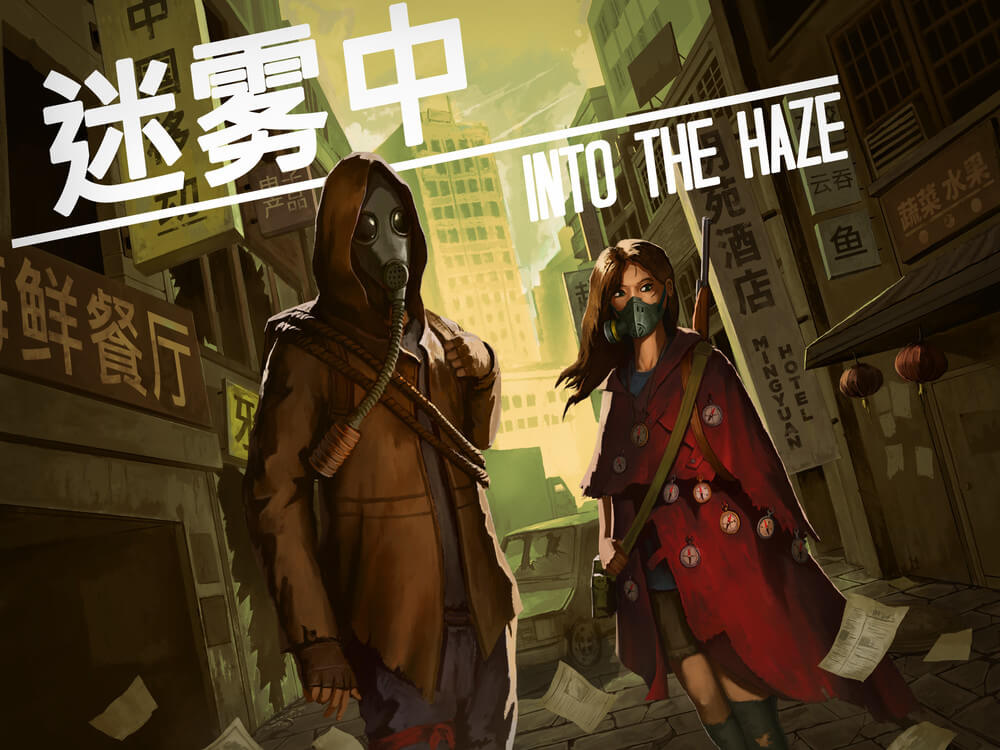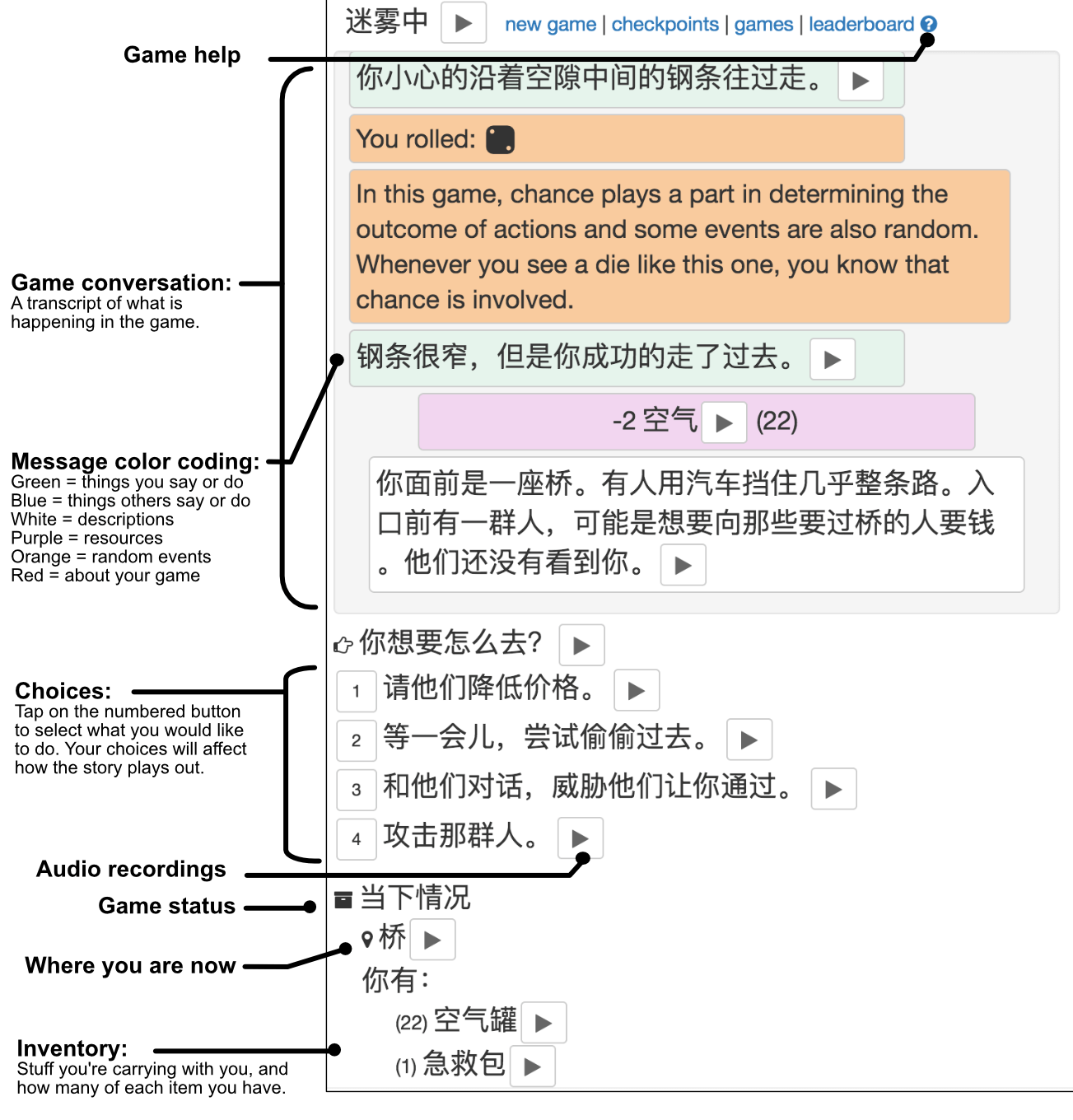I think games have huge potential for language learners. This is true of most games, even if the games themselves have nothing to do with language learning, but it’s even more true for games that are designed with that in mind.
Into the Haze is such a game. Like it’s predecessor, Escape, it’s a text adventure game for Chinese learners. In short, think of it as an interactive graded reader. You can read or listen to the text, make your choice about how to proceed and the game will develop differently depending on what you choose. If you make bad choices, perhaps because you didn’t fully understand the options, you might fail and will have to try again.
This short video explains it all:
You can try Into the Haze for free (requires signing up, which is free) here! For full access to the game you need a subscription at WordSwing. More information about how all this works can be found here.
Into the Haze: A new text adventure game for Chinese learners
I would have loved to have access to such a game ten years ago, so I’m very proud to announce Into the Haze. This game is much closer to what I originally wanted to create than Escape was. This time, the setting is also more interesting. In a post-apocalyptic world, you have to go into a fallen city covered in a poisonous haze to find your missing brother. Just look at the gorgeous artwork by Kerim Akyuz!
What it’s about and whom it’s good for
Into the Haze is an interactive graded reader where you need to both understand the text and/or audio, and make the right decisions to find your brother and get back home. Succeeding requires you to actively engage with the text and/or audio and understand what is best to do in a given situation. Don’t feel bad about making mistakes, though, failure is a necessary part of the learning process! Exploring the whole game should take many, many hours. Capturing the top position on the leader board should be really challenging.
Playing this game is a much more active form of reading and/or listening than just following along a normal text or audio clip where you can’t change the story and where your understanding is not tested at all. In this game, you need to actively engage the content and understanding it well is rewarded.
If the game is suitable for you or not depends on how much effort you’re willing to put into it. The game only has little more than 600 unique characters, so…
- …if you know about 500 characters, you should be okay, even if you will need the built in dictionary when guessing from context is not enough.
- …if you know 200 characters or less, this game will be very hard and is not recommended unless you really, really want to play.
- …if you know 1500 characters, this will be a form of extensive reading for you, which is also good, but of course less challenging.
How to play
As mentioned above, the game consists of a series of choices that allow you to direct how your character responds to each situation. The game will show descriptions of the scenes, describe the results of the actions you take, as well as show dialogues that occur in the game.
Things you say or do are shown in green and appear towards the left, while things other characters say or do are shown in blue, and appear towards the right, kind of like a messaging app. There are random elements in the game, which are shown in orange. You also have resources you need to manage, which are shown at the bottom and any changes are shown in purple.
Messages are presented one at a time so you can have time to read and digest each one. You make a choice by tapping or clicking on one of the numbered buttons next to the choice. Click the play button to hear audio. There is also a built-in dictionary you can use if you come upon a word you don’t understand.
Here’s a brief explanation of the interface:
Read more about how the game works here
WordSwing
This game is available through WordSwing, a project I’ve worked on for some time now together with Kevin Bullaughey. The goal is to provide engaging and effective ways of consolidating, activating and expanding your Chinese vocabulary. This game is part of an effort to provide more interesting ways of exploring Chinese reading for intermediate learners. I will write more about WordSwing later, but regular readers might remember the tone course, which was also provided through WordSwing. Both these projects were jointly developed by Kevin and me; expect to see more such collaborations in the future!



10 comments
You’ll never be on the leader board. The people on there play the game obsessively, every day. That’s the problem with these “game-ified” apps, they appeal to the wierdos out there and we mere mortals never have a chance. The only thing missing is microtransactions to buy clues to the next mystery, which I assume are coming soon.
Right now it’s definitely possible, because the game has been out for about a day. 🙂 There are no plans to introduce anything that costs anything, apart from full access, which is already implemented. If you have any suggestions for how we can continue working with this and develop more learning resources, please let us know! It takes hundreds of hours to develop something like this so it’s not something we can continue doing on our spare time.
That’s really nice artwork–who’s the artist? (Of course, the games themselves are good too!)
It says in the article! His name is Kerim Akyuz.
Thank you! Can’t believe I missed that sentence…
This looks SO exciting, and my family would be really motivated by a game like this, as we’re all four learning to read and write Chinese, and our two kids are very game obsessed. We’re currently at 100, 400, 600, and 900 characters, so the game looks perfect for our level. However, my husband is from Taiwan and we’re learning to read traditional characters. After you pay, is there any way to switch to traditional characters, or simplified the only option?
Hi! At the moment, there’s only simplified. The ambition is of course to provide traditional as well (both Kevin and I learnt mostly traditional actually), but we need to show that the game is actually something students want before we invest much more time and money. 🙂
Nice artwork; pity about the ugly script. Let us know when you have proper characters, 正體字. 😉
BTW, “whom” is not really appropriate for that register or word order (“it’s good” and a preposition at the end of the clause show the register).
This game is an awesome tool. Many thanks and much respect for allowing it to be free.
I would pay for access.
Actually, the full version of the game does require a paid account. 🙂